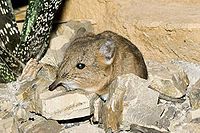
Elephant shrew
Background to the schools Wikipedia
SOS Children offer a complete download of this selection for schools for use on schools intranets. See http://www.soschildren.org/sponsor-a-child to find out about child sponsorship.
| Elephant shrews Temporal range: Early Oligocene to Recent |
|
|---|---|
 |
|
| Short-eared Elephant Shrew (Macroscelides proboscideus) |
|
| Scientific classification | |
| Kingdom: | Animalia |
| Phylum: | Chordata |
| Class: | Mammalia |
| Infraclass: | Eutheria |
| Superorder: | Afrotheria |
| Order: | Macroscelidea Butler, 1956 |
| Family: | Macroscelididae Bonaparte, 1838 |
| Genera | |
|
Rhynchocyon |
|
Elephant shrews or jumping shrews are small insectivorous mammals native to Africa, belonging to the Macroscelididae family, in the order Macroscelidea. Their traditional common English name comes from a fancied resemblance between their long noses and the trunk of an elephant, and an assumed relationship with the true shrews (family Soricidae) in the order Insectivora. As it has become plain that the elephant shrews are unrelated to the shrews, the biologist Jonathan Kingdon has proposed that they instead be called sengis, a term derived from the Bantu languages of Africa.
They are widely distributed across the southern part of Africa, and although common nowhere, can be found in almost any type of habitat, from the Namib Desert to boulder-strewn outcrops in South Africa to thick forest. One species, the North African Elephant Shrew, remains in the semi-arid, mountainous country in the far north-west of the continent.
Characteristics
Elephant shrews vary in size from about 100 mm to almost 300 mm, from just under 50 g to over 500 g. The Short-eared Elephant Shrew has an average size of 150 millimetres (5.9 in). All are quadrupedal with mouse-like tails, and rather long legs for their size, and although the size of the trunk varies from one species to another, all are able to twist it about in search of food. Their life span is about two or three years. Their diet is largely insects and other small creatures, particularly beetles, spiders, worms, ants, and termites, mostly gleaned from leaf litter, but they also take seeds and some green shoots. They have large canine teeth, and also high-crowned cheek teeth like those of ungulates. Their dental formula is:
| Dentition |
|---|
| 1-3.1.4.2 |
| 3.1.4.2-3 |
Although mostly diurnal and very active, they are difficult to trap and very seldom seen: elephant shrews are wary, well camouflaged, and adept at dashing away from threats. Several species make a series of cleared pathways through the undergrowth and spend their day patrolling them for insect life: if disturbed, the pathway provides an obstacle-free escape route.
Elephant shrews are not highly social animals, but many live in mongamous pairs, which share and defend a home territory, which they mark using scent glands. The Rhynchocyon species also dig small conical holes in the soil, bandicoot style, but others may use natural crevices, or make leaf nests.
Females give birth to litters of one or three young several times a year, after a gestation period varying from 45 to 60 days. The young are born relatively well developed, but remain in the nest for several days before venturing outside.
Classification
In the past, elephant shrews have been classified with the shrews and hedgehogs as part of the Insectivora; regarded as distant relatives of the ungulates; grouped with the treeshrews; and lumped in with the hares and rabbits in the Lagomorpha. Recent molecular evidence, however, strongly supports a superorder Afrotheria which unites tenrecs, and golden moles with certain ungulates or mammals that were previously presumed to be ungulates, including hyraxes, sirenians, aardvarks and elephants, as well as the elephant shrews.
A number of fossil species are also known, all of them from Africa. Some, such as Myohyrax, were so similar to hyraxes that they were initially misidentified as belonging to that group, while others, such as Mylomygale were relatively rodent-like. These unusual forms all died out by the Pleistocene.
There are 16 species of elephant shrew in four genera, two of which are monotypic.
- ORDER MACROSCELIDEA
- Family Macroscelididae
- Genus Elephantulus
- Short-snouted Elephant Shrew, Elephantulus brachyrhynchus
- Cape Elephant Shrew, Elephantulus edwardii
- Dusky-footed Elephant Shrew, Elephantulus fuscipes
- Dusky Elephant Shrew, Elephantulus fuscus
- Bushveld Elephant Shrew, Elephantulus intufi
- Eastern Rock Elephant Shrew, Elephantulus myurus
- Somali Elephant Shrew, Elephantulus revoili
- North African Elephant Shrew, Elephantulus rozeti
- Rufous Elephant Shrew, Elephantulus rufescens
- Western Rock Elephant Shrew, Elephantulus rupestris
- Genus Macroscelides
- Short-eared Elephant Shrew, Macroscelides proboscideus
- Genus Petrodromus
- Four-toed Elephant Shrew, Petrodromus tetradactylus
- Genus Rhynchocyon
- Golden-rumped Elephant Shrew, Rhynchocyon chrysopygus
- Checkered Elephant Shrew, Rhynchocyon cirnei
- Black and Rufous Elephant Shrew, Rhynchocyon petersi
- Grey-faced Sengi , Rhynchocyon udzungwensis
- Genus Elephantulus
- Family Macroscelididae

